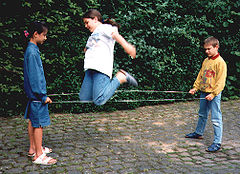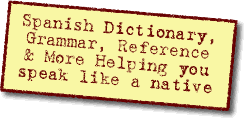Ask a Question(Create a thread) |
|
|||||||
Translation homeworkPractice your Spanish or English! Try to reply in the same language as the OP. |
 |
|
|
Thread Tools |
|
Get rid of these ads by registering for a free Tomísimo account.
|
|
#3
|
||||
|
||||
|
4. --¿Tenías peces de pequeño? Did you have fish when you were little?
--No. Tenía tortugas. No. I had turtles. 5. --¿Jugabas con camiones cuando eras niña? Did you play with trucks when you were a little girl? --Sí, y también con animales de puluche. Yes, and also with stuffed animals. |
|
#4
|
||||
|
||||
|
The first one is correct.
But there are more choices for that the sentence sound better. For example, you can say. Tenias peces de pequeño? Did you have fish when you were a little? If you can see the difference between the two sentences and my sentence and you sentence. What is words too much? But please you can analyze the possibility to change the word for the mine, because it would sound more nature than your own sentence. Have fun.
__________________
We are building the most important dare for my life and my family feature now we are installing new services in telecoms. 
|
|
#5
|
||||
|
||||
|
There are only two things wrong with the two Spanish sentences in post #3. Jessica has given great English translations of the sentences!
The first problem is that the spelling of puluche is still wrong. It's right in another sentence, so this was just another typo. The second problem, although I let it slide before because I believe she probably copied de pequeño straight from her textbook, is that the textbook is using a 'generic' form of the last word. If a girl is being addressed (asked the question), pequeña should be used instead: ¿Tenías peces de pequeña? |
|
#7
|
||||
|
||||
|
That's the 'generic' form. Using the 'masculine' form is not uncommon, in a textbook setting. Your teacher should have pointed out that an adjective used to describe oneself must agree with one's gender.
* Some adjectives keep the same ending, regardless of the subject's gender. |
|
#11
|
||||
|
||||
|
jugar a la goma ( elastica ) es esto:
  Niñas y un niño jugando a la goma Esto es guiar un aro:  El aro, también llamado 'reduncho'. La carrera con aros está muy difundida por Aragón. Es un juego de habilidad y de velocidad. El aro, también llamado 'reduncho'. La carrera con aros está muy difundida por Aragón. Es un juego de habilidad y de velocidad.¿De dónde proceden los aros? De las asas de los cubos o pozales, aros de los toneles, llantas de bicicletas... llevándolos con un alambre grueso que cada jugador acomoda a su modo, según sea diestro o zurdo, haciéndolo rodar sin que se caiga. Material. El aro es metálico, de 40 cm. de diámetro, forma plana, redonda y la guía es una varilla de 6 mm. de grosor por 60 cm. de largo, con un mango de madera en el extremo para sujetarlo con la mano. En la otra punta hay una muesca para hacer rodar el aro y sujetarlo al inicio. Terreno de juego. Puede ser cualquier calle, era, patio, con o sin obstáculos, haciendo carreras entre 6 ó 10 personas. También se presta para realizar pruebas de habilidad por los circuitos establecidos y recorrer una distancia cronometrando el tiempo. Esto es jugar a la peonza  Jugar a la peonza Y jugar al hinque es con una barra de hierro, y había que hincarla en el barro y tratar de sacar el hinque del compañero. ANY IDEAS IN ENGLISH? Last edited by Rusty; November 15, 2009 at 05:57 PM. Reason: merged, added special characters dropped during copy-n-paste |
|
#13
|
||||
|
||||
|
Jugar a la goma, en México es jugar resorte y jugar a la peonza es bailar un trompo o jugar al trompo.
Ese tipo de aro no se usa por aquí.
__________________
♪ ♫ ♪ Ain't it wonderful to be alive when the Rock'n'Roll plays... ♪ ♫ ♪ |
 |
«
Previous Thread
|
Next Thread
»
| Link to this thread | |
|
|
|||||||
 Similar Threads
Similar Threads
|
||||
| Thread | Thread Starter | Forum | Replies | Last Post |
| More homework - translation | Jessica | Practice & Homework | 3 | April 29, 2009 03:53 PM |
| More translation homework | Jessica | Practice & Homework | 14 | April 15, 2009 07:23 PM |
| Translation homework | Jessica | Practice & Homework | 4 | April 07, 2009 09:32 PM |
| More translation homework | Jessica | Practice & Homework | 6 | February 22, 2009 05:15 PM |
| Translation homework | Jessica | Practice & Homework | 3 | February 18, 2009 07:13 PM |
All times are GMT -6. The time now is 07:24 PM.









